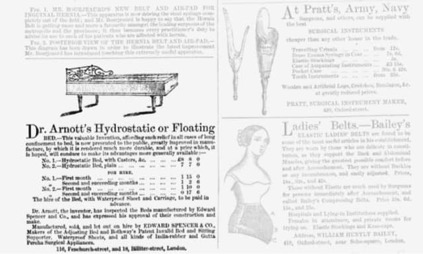by Nancy Mitchell Feb 11, 2018 Apartment Therapy
If you've ever slept on a waterbed, you know that it is a singular experience. My cousins had one growing up, and I thought it was the most fascinating thing — I had never dreamed that sleep could feel (or, let's be honest, sound) like that. Almost since its invention, the waterbed has been associated with excitement and even licentiousness — but ever since the late 1980s, when the waterbed hit its peak, it's been slowly disappearing from the American home, if not the American consciousness. Read on the for the weird true story of the rise and fall of the waterbed.
The waterbed, as we know it, got its start in California, in the late sixties. After experimenting with chairs filled with cornstarch and even Jell-o, Charlie Hall, a design student at San Francisco State University, hit upon the idea of a mattress full of water. Hall presented the water-filled mattress as his master's thesis one evening in 1968, and his entire class spent the night frolicking on it. Thus the modern waterbed was born.
Hall wasn't the first person to come up with the idea of filling a mattress with water. In the early 1800s, Dr. Neil Arnot created a 'hydrostatic bed for invalids' that was intended to reduce bedsores. The bed consisted of a warm bath filled with water and topped with a layer of rubber, which was then sealed to prevent leaks. And science fiction writer Robert Heinlein, inspired by the time he spent bedridden with tuberculosis, described a waterbed in great detail in one of his books, although he never bothered to build it.
But it was modern technology that really made the waterbed possible. The invention of vinyl meant that a mattress that would reliably hold water and not leak was a real possibility, so Hall began his experiments at just the right time. Of course, it was the swinging sixties, and marketers quickly picked up on the waterbed's more tantalizing possibilities. One company claimed that "Two things are better on a waterbed. One of them is sleep." Hall sold waterbeds to members of Jefferson Airplane and to Hugh Hefner. In 1971, Time reported that, "in Manhattan, the waterbed display at Bloomingdale's department store for a while was a popular singles meeting place."
In the 1980s, the waterbed successfully made the leap from bachelor pad to suburban bedroom. At the peak of the waterbed craze, in 1987, more than one out of five mattresses purchased in the U.S. were waterbeds — meaning that enjoying that sweet, sloshy sleep was almost mainstream. But since then, their market share has declined to a lowly five percent. What happened?
Some people have attributed the decline of the waterbed to their association with creepy '70s lotharios, but their popularity with suburbanites in the '80s seems to refute that. I think the real problem with waterbeds was that they were kind of a pain. Installing one meant running a hose into your bedroom, risking flood-like conditions. Moving a waterbed was even more complicated, requiring an electric pump or another device to siphon out the water. And the wooden frames could weigh hundreds of pounds. Plus there was the possibility of your mattress springing a leak, or growing algae (although, to be fair, this could be avoided by adding a little Clorox to the water upon the initial filling). Many apartment complexes banned them.
But the modern waterbed still had its adherents — and it might look (and feel) much different than you'd expect. New softsided, or 'waveless', water beds lack the telltale wood frame of the old models. They consist of a water-filled pouch or coils surrounded by foam sides, and look just like a standard mattress. Separating the water into multiple compartments cuts down on the wave action, which makes for a bed that's just as supportive and not nearly as sloshy (although maybe also not nearly as fun).
Oddly, waterbeds may be finding a new market, but not a human one. Time, which first reported on the popularity of the waterbed in 1971, published an article in 2012 about the trend of buying waterbeds for cows. Yes, cows. Apparently this unconventional accommodation helps to reduce sores and infections, and is less likely to grow bacteria than beds of traditional materials like wood chips. There are entire companies devoted to producing waterbeds for cows. As one Oregon farmer put it: "Happier cows, happier milk."
So, in its own way, the waterbed persists. It may have disappeared, for the most part, from the American bedroom, but in the American psyche (and maybe the American farm), Charlie Hall's unusual invention still looms large.






